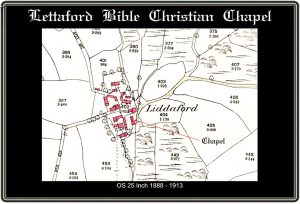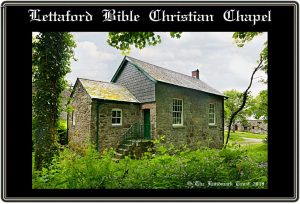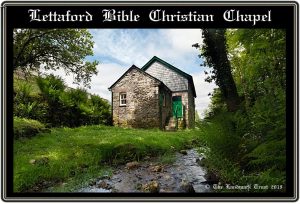
Lettaford is a small hamlet situated on an old packhorse track a few miles to the west of North Bovey. The earliest record of the hamlet appeared in the Assize Rolls of 1244 as Lottreford then down through the centuries it mutated into Litterford, Liddaford until arriving at today’s Lettaford. The English Place-Name Society suggests that the name stems from the Old English word – hlutor meaning clear, pure or bright. This could well allude to the small stream which flows through the hamlet before joining the North Wallabrook Today, Lettaford is known for its old granite longhouses and specifically the picturesque one known as Sanders. However, in this instance it’s what was one the tiny chapel belonging to the Bible Christians and its interesting history that concerns this page.
In his book of 1868 G. Stevenson wrote; “The birthplace of the Bible Christian Society was Devonshire, in that county a large proportion of its members and ministers were born, and there the denomination has its chief stronghold…” The Bible Christian Church was first founded by one William O’Bryan, a Cornishman born in Gunwen in 1778 he founded the Bible Christian movement on the 9th of October 1815. From that date he began preaching around the remoter villages and hamlets of Devon and over the years the membership slowly grew. Many of these remoter communities were neglected by other Christian movements hence the increase in popularity. However, with such widespread ministries there was an ever growing financial need which soon outgrew itself. The only solution was to join with other denominations and in 1907 the Bible Christians amalgamated with both the United Methodist Free Churches and the Methodist New connection thus forming the United Methodist Church. In 1932 the United Methodist Church joined forces with the Wesleyan Church and the Primitive Methodist Church thus forming the modern Methodist Church.
In 1907 Lettaford Chapel belonged to the Chagford Curcuit of the Bible Christians which at that time comprised of 192 members, 3 ministers and 7 chapels. Lettaford was one of the earlier chapels which was opened in 1860 and first held services in what was then the schoolroom. Previous to using the schoolroom members had been meeting in one of the two cottages which stood near the bridge. Eventually these tenants of these cottages left the buildings fell into disrepair and as noted above services were held in the schoolroom which at the time was owned by the Misses Splatt. When the sisters retired they kindly donated the schoolroom to the Chagford Circuit for their worship. Then came a bitter episode in the chapel’s history when William Perryman (a farmer from Yeo Farm, Chagford) arrived at the chapel to preach and found folk milling around outside. The reason soon became evident when he discovered that the door to the chapel and been fastened with a padlock and chain. In the spirit of ‘Onward Christian Soldiers’ he borrowed a file from a nearby farmer and filed the chain off. On another occasion the preacher arrived at the chapel and once again found it padlocked, again this was broken off and the service held. Then Mr. Perryman received a letter from a lawyer warning that if legal action would be taken if the building was ever forcibly entered again. A meeting was then arranged between Perryman, the lawyer and his client where it was stated that the chapel in fact stood in the clients garden. An OS map was produced which clearly showed that the chapel stood on the common land and not the clients property. Having resolved the matter services once again continued with no further instances of chains and padlocks. Well, that’s not entirely true because the chapel stood beside a trans-moor track (now the Mariner’s Way) it was often used by cattle drovers it was necessary to fix a chain across the door to prevent the cattle from entering which that being the case there musty have been previous times when they had?
One of the more devoted members, Mr. William Chammings took on the responsibility of the chapel’s caretaker who in winter always ensured a fire was lit and the oil lamps fully fuelled and lit. On some occasions the Chagford based members would turn up with a farm wagon on which and organ and the choir laid on a service of song, this was held on the neighbouring green at Jurston. In 1913 farmer Osbourne from Liapra travelled up it Hittisleigh Chapel with his cart to collect an old harmonium which was brought back for service at Lettaford. On the following Sunday Mr. Wallace Perryman was the first man to play the new harmonium and was a duty that he carried on until his new organ arrived in 1943. It was also in this year that gas lighting was installed which replaced the old oil lamps, this too was eventually replaced in 1962 when electricity was installed. Despite all the modern alteration the congregation began to dwindle and by 1962 had fallen to just four members. Clearly with such small numbers it became difficult to maintain the chapel and in 1977 the Lettaford chapel joined with the Chagford one who also had suffered declining numbers. This then led to the final closure of the chapel in 1978 but not the end of its story. Having already restored the nearby longhouse of Sanders the Landmark Trust acquired the redundant chapel in 1981. Today Lettaford Chapel has been restored by the Landmark Trust and is now a holiday let which will accommodate 2 people at the very reasonable price of around £23 a night per person. If you fancy staying in this historic building located in the picturesque Lettaford hamlet you can find details on their website – HERE, and its guaranteed that if you do you will not find the door chained and padlocked. What you will find is a very peaceful,comfortable and well equipped holiday home located in the heart of Dartmoor and all its delights.
Below is a brief account of Arthur Wade’s visit to a Harvest Festival at Lettaford Chapel which at the time shows what a busy and friendly place it was:
“Descending the lane we arrived at the tiny Lettaford chapel in good time for the service, and we found it almost full, and the waiting interval gave us an opportunity to admire the very clever and artistic way in which the fruits of God’s good earth – moorland, if you like – had been arranged by loving hands on the walls, where every cill, projection, and niche held its own variety of the good harvest…
The chapel had such a friendly atmosphere that we felt at home at once. Everybody living around there seemed to be present including mothers and babes in arms. All those simple, good-living folk belong to a hardy race, and I could easily see that they had toiled long and hard in the fields to save their precious harvests, and it seemed so fitting that they should gather together like this to offer their thanks and prayers in the moorland chapel so near the scene of their labours. It was a memorable experience for me, and I could not help responding to that air of happy thankfulness in such a family setting. The only visitors from a distance, besides ourselves, were a member of the Woman’s Land Army and a soldier, who had ridden over on his bicycle, and it was nice to see them there.
Sitting near the door, which was left open before the service commenced, I could hear some ducks which were disporting themselves and having a grand time in a moorland stream a few paces from the door. The oil lamps added their homely touch to that happy interior, and the way those good people sang the well-loved hymns of praise and thanksgiving was a great treat to me. An elderly farmer sitting next to me so thoroughly enjoyed enjoyed his singing that he did not miss a single note or word. Indeed his hearty example made me sing in sheer competition with him. And the preacher, on opening his sermon, referred to the good things of the earth which were displayed around him, and expressed wonder that they were grown on Dartmoor, whereupon a farmer in front exclaimed, with such a feeling of pride, “‘Yes, sir, they were.‘” – Arthur Wade, The Western Times, January 1st, 1943.

Stevenson, G. 1886. Methodist Worthies – Vol. 2, London: Thomas C. Jack.
Thorne, R. 1975. The Last Bible Christians. Transactions of the Devonshire Association – Vol. 107. Torquay: The Devonshire Press.
Wade, A. 1943. My Moreton Scrapbook. The Western Times.
 Legendary Dartmoor The many aspects past and present of Dartmoor
Legendary Dartmoor The many aspects past and present of Dartmoor



